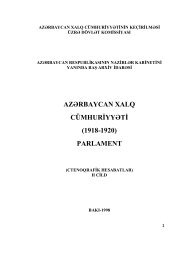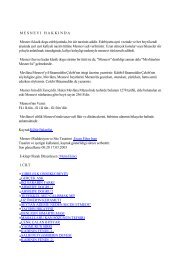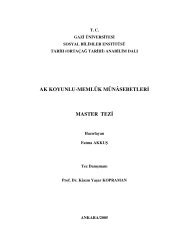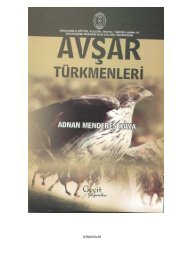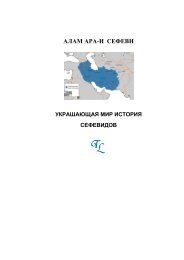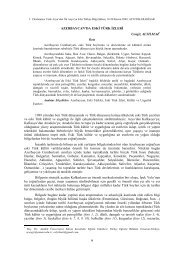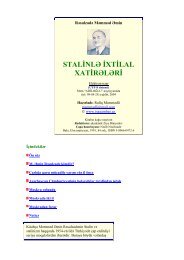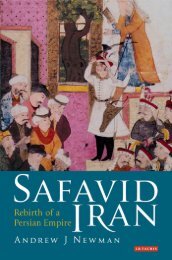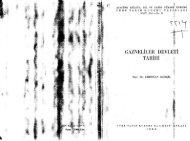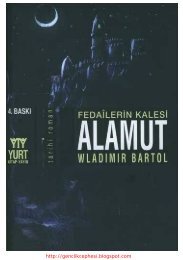War and Peace in Qajar Persia: Implications Past and ... - Oguzlar.az
War and Peace in Qajar Persia: Implications Past and ... - Oguzlar.az
War and Peace in Qajar Persia: Implications Past and ... - Oguzlar.az
- No tags were found...
Create successful ePaper yourself
Turn your PDF publications into a flip-book with our unique Google optimized e-Paper software.
48 Stephanie Cron<strong>in</strong>capacity <strong>and</strong> resist grow<strong>in</strong>g European hegemony <strong>and</strong> direct or <strong>in</strong>direct control,by imitat<strong>in</strong>g European methods of military organization <strong>and</strong> warfare.Almost every <strong>in</strong>digenous ruler who succeeded <strong>in</strong> evad<strong>in</strong>g or ward<strong>in</strong>g off directEuropean control, from the sultans of pre-Protectorate Morocco <strong>in</strong> the westto the shahs of the <strong>Qajar</strong> dynasty <strong>in</strong> Iran <strong>in</strong> the east, <strong>in</strong>vited European officers,sometimes as <strong>in</strong>dividuals, sometimes as formal missions, to assist withbuild<strong>in</strong>g a modern army. 1 With the help of these officers, Middle Easternrulers thus sought to appropriate the secrets of European power. 2Early attempts by Middle Eastern rulers to modernize their militaryforces were partly driven by shock at successive defeats by European powers,especially by the relentless Russian conquests of Ottoman <strong>and</strong> Iranianterritory <strong>and</strong> the consequent extension of <strong>in</strong>fidel control over Muslim populations.Napoleon’s occupation of Egypt <strong>in</strong> 1798, although temporary, providedboth a rem<strong>in</strong>der of local military weakness <strong>and</strong> an impressive displayof the power of a modern army. There were, however, other equally importantmotives for military reform. In the early n<strong>in</strong>eteenth century, MiddleEastern rulers still harboured ambitions of reconquer<strong>in</strong>g territories lost toEuropean expansion <strong>and</strong> hoped to develop modern armies with offensive capacities,such capacities also prov<strong>in</strong>g useful <strong>in</strong> enhanc<strong>in</strong>g their regional st<strong>and</strong><strong>in</strong>gvis-à-vis other local states. Perhaps most importantly, by creat<strong>in</strong>g a modernarmy loyal exclusively to themselves, the Ottoman <strong>and</strong> Moroccan sultans,the beys of Tunis, the shahs of Iran <strong>and</strong> Muhammad Ali of Egypt also hopedto equip their dynasties with a coercive weapon capable of quell<strong>in</strong>g domesticopposition <strong>and</strong> buttress<strong>in</strong>g their own personal power as expressed <strong>in</strong> theform of a modern autocratic state.The protracted struggles of these rulers to build up military forces capableof defend<strong>in</strong>g their realms from external attack largely failed. Yet theOttoman example, <strong>and</strong> the more temporary achievements of Mohammad Ali<strong>in</strong> Egypt <strong>in</strong> the 1820s <strong>and</strong> 1830s, were of immense importance <strong>in</strong> spread<strong>in</strong>gideas of military reform throughout the Middle East <strong>and</strong> North Africa. Theadoption of European methods by rulers as strong <strong>and</strong> assertive as MohammadAli or with the prestige of the Ottoman sultan-caliph, made these <strong>in</strong>novationspalatable <strong>and</strong> even desirable to wider Muslim op<strong>in</strong>ion. The routes bywhich modern concepts of military organization <strong>and</strong> <strong>in</strong>novations <strong>in</strong> militarytechnology were transmitted throughout the Middle East <strong>and</strong> North Africawere complex. N<strong>in</strong>eteenth-century Europe itself offered no s<strong>in</strong>gle model ofmilitary development, <strong>and</strong> Middle Eastern countries <strong>in</strong> general appear to havebeen <strong>in</strong>fluenced much more by each local effort at reform than directly bythe unmediated European example. 3Iran <strong>in</strong> particular seems to have been fasc<strong>in</strong>ated by the Ottoman experience.In its military reforms, Iran shared many of the Ottoman Empire’s goals.Iran, like the Ottoman Empire, conceptualized its military needs <strong>in</strong> terms ofa large multi-functional army, based on mass conscription. Although the latertriumphs of European imperialism, <strong>in</strong> which Iran has been cast as passivevictim, have tended to obscure this motive, the <strong>Qajar</strong> shahs wanted a large



